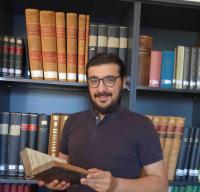Manuscript sa 299L, a fragmentary Holy Week lectionary, is one of the primary sources of my ongoing PhD project on the Sahidic Holy Week lectionaries. Its fragments were first put together and described by Franz-Jürgen Schmitz and Gerd Mink in their catalog in 1991.[1] In their suggested reconstitution, the scholars included one mutilated leaf preserved in the Bibliothèque nationale de France in Paris (BnF) under call number Copte 129.19, f. 85. Although that leaf contained only Psalm chapters, and, what is more, Psalm chapters never resorted to in Holy Week lectionaries, it seems that the two scholars were misled in two respects. Firstly, they mistook the several framed headings for headings of liturgical rubrics (‘Lesungseinleitungen’, I, 2.2, p. 852) whereas they are short titles summarizing the content of the chapters at issue. This mistake can be explained by the fact that such headings do not correspond to the traditional superscriptions in the psalter (see below). Secondly, they were misled by the similarity of this folio with sa 299L in terms of number of lines per page (around 36) and paleography. In 2004, in her article on the Sahidic Holy Week lectionaries, Diliana Atanassova already expressed her doubts as to the belonging of folio 85 to the Holy Week lectionary sa 299L.[2] In her comprehensive overview of the new findings related to the Sahidic Holy Week lectionaries in 2018, on pages 26-27, Atanassova published a new reconstitution of the extant folios belonging to sa 299L, definitely discarding folio 85.[3] However, she did not suggest a new codex to which the folio could belong.
Building on the characteristics of the leaf at issue and on the concluding words by Atanassova in her blog article on Codex sa 2033 (BC sa 101) dated August 22, 2019,[4] I consulted the photo archive of the Göttingen Digital Edition of the Coptic Old Testament project. Together with a project internal database developed by Malte Rosenau, it helped me find out to which codex this leaf could belong.
Some relevant properties of folio 85 can be summarized as follows: it contains Sahidic versions of Ps 145, 8-10 and Ps 146, 1-11 on its recto, and of Ps 147, 1-9 and Ps 148, 1-6 on its verso. The heading and the beginning of the first verse of Ps 146 and Ps 148 are in italics and framed by horizontal strokes and dots retraced in red. The end of each verse is marked by a black dot over a bigger red one. There is one colored animal drawing on the bottom margin of each side of the leaf. Interestingly, all these features are characteristic of sa 2033.[5]
This allows us to assume that folio 85 actually belongs to sa 2033, the extant constituents of which present the same paleography, the same decoration of chapter headings, the same type of miniatures in the margins. Going through all the pages that can be seen on the Virtual Manuscript Room (VMR) (sa 2033) of the Göttingen project, another surprise comes up: this newly discovered addition finds its exact position immediately after the Vienna fragmentary folio K 9857, pp. ⲣ︦ⲝ︦ⲍ︦/ⲣ︦ⲝ︦ⲏ︦ (167/168), F/H of codex sa 2033, which contains parts of Ps 143 and 144. This enables us to reconstruct the pagination of folio 85 as [ⲣ︦ⲝ︦ⲑ︦]/[ⲣ︦ⲟ︦] (= [169]/[170]). Moreover, the recto of the Paris folio is the hair side and the verso is the flesh side of the parchment. Thus, Gregory’s rule[6] confirms once more the correct position of the new folio within the structure of sa 2033.
We can therefore conclude by saying that — including the folio discovered by Atanassova in 2019 and the folio discussed here — the identified parts of sa 2033 now sum up to 25 (fragmentary) folios, dispersed among 6 libraries.
My work on this folio also uncovered an important feature of sa 2033 not registered until now in the descriptions of this codex. In fact, headings such as those mentioned in the beginning of this blog article, which were mistaken for liturgical rubrics by Schmitz and Mink, can be found at the beginning of each Psalm in codex sa 2033.
As is well known, some of the Psalms of the Hebrew Bible contain superscriptions (titles or instructions). In the Septuagint these superscriptions were partially altered and increased in number.[7] However, the headings found in sa 2033 are of another nature which rather reminds us of the Psalm titles which have been added by some Bible translators and editors in modern times. E.g. the beginnings of Ps 146 and 148 found on folio 85 are:
Ps 146: [ⲉⲧⲉⲥ]ⲙⲏ ⲙ̄ⲡⲉⲭ︦ⲥ︦ ⲛⲁϩⲣⲙ̄ ⲡⲗⲁⲟⲥ ‘On the voice of Christ before the people’
1 [ⲁⲗ]ⲗⲏⲗⲟⲩⲓⲁ [ⲥⲙⲟⲩ ⲉⲡ]ϫⲟⲉⲓⲥ … Hallelujah. Praise the Lord…
Ps 148: ⲉⲧⲉⲥⲙⲏ ⲛⲧⲉⲕⲕⲗⲏⲥⲓⲁ ⲛⲁϩⲣⲙ̄ ⲡⲗⲁⲟⲥ ‘On the voice of the Church before the people’
1 [ⲁ]ⲗⲗⲏⲗⲟⲩ[ⲓⲁ] ⲡⲁ[ⲅⲅⲁⲓⲟⲥ ⲙⲛ ⲍⲁⲭⲁ]ⲣⲓⲁⲥ Hallelujah, of Haggai and Zechariah…
While the underlined part of Ps 148,1 clearly belongs to the Septuagint tradition, the titles in bold are specific to this Sahidic manuscript and the wording shows that they are late interpolations, probably made by a Christian scribe to link the Old Testament to the New Testament. A similar procedure can be observed all over sa 2033. The origin of these headings is a subject for future research.[8] All that can be said for now is that, to my knowledge, no other Sahidic Psalter shows this particularity, and there seems to be no trace of it either in the Septuagint or in other ancient OT translations.
[1] Schmitz, Franz-Jürgen/Mink, Gerd (1991). Liste der Koptischen Handschriften des Neuen Testaments, I, Die sahidischen Handschriften der Evangelien. Teil 2,2 (Arbeiten zur neutestamentlichen Textforschung 15). Berlin/New York: De Gruyter.
[2] Atanassova, Diliana (2004). Zu den sahidischen Pascha-Lektionaren, in: Mat Immerzeel and Jacques van der Vliet (eds), Coptic Studies on the Threshold of a New Millenium I. Proceedings of the Seventh International Congress of Coptic Studies Leiden, 27 August – 2 September 2000 (Orientalia Lovaniensia Analecta 133). Leuven: Peeters, 607–620.
[3] Atanassova, Diliana (2018). Neue Erkenntnisse bei der Erforschung der sahidischen Quellen für die Paschawoche, in: Heike Behlmer, Ute Pietruschka and Frank Feder (eds), Ägypten und der Christliche Orient. Peter Nagel zum 80. Geburtstag (Texte und Studien zur Koptischen Bibel 1). Wiesbaden: Harrassowitz, 1–37.
[4] Atanassova, Diliana (2019). Neues Blatt aus der Bodleian Library für den Psalterkodex sa 2033 (BC sa 101).
[5] For the characteristics of sa 2033, see Atanassova, Neues Blatt.
[6] I.e., a hair side is always followed by a hair side and a flesh side by a flesh side forming the quire folding pattern F/H-H/F. See C. R. Gregory, Les cahiers des manuscrits grecs, in: CRAI 13 (1886), 261–268, in particular p. 265.
[7] Stichel, Rainer (2007). Beiträge zur frühen Geschichte des Psalters und zur Wirkungsgeschichte der Psalmen. Paderborn et al.: Verlag Ferdinand Schöningh, 37–105.
[8] I would like to thank Professor Rainer Stichel for giving me some valuable hints for further investigation of this particularity.
 Blogs
Blogs  בלוגרים אחרונים
בלוגרים אחרונים 




